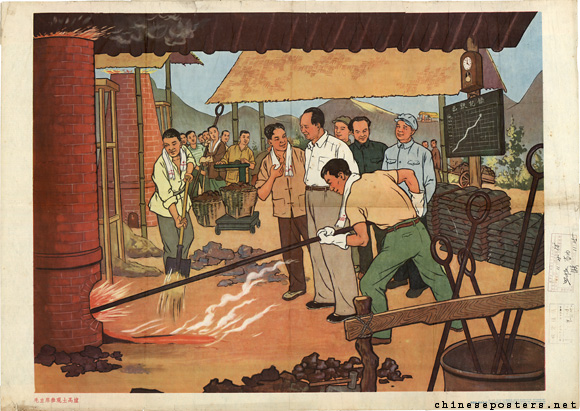More languages
More actions

The Great Leap Forward (Simplified Chinese: 大跃进; Pinyin: Dà yuèjìn) was an economic and social campaign in China during the Second Five-Year Plan. During the Great Leap Forward, peasants, who had already collectivized land, joined large communes of thousands of people. They tried to produce steel in small rural foundries, also known as backyard steel furnaces. Mao admitted that policy errors occurred and took responsibility for them, but Western claims of mass starvation are widely exaggerated.[1]
Famine
Western sources often claim that the largest famine in history took place during the Great Leap Forward. Official Chinese documents released after Mao's death put the death toll at 16.5 million, which may be exaggerated, while bourgeois sources claim that 30 or even 38 million people died.
It is true that agricultural production decreased in five years between 1949-1978 due to “natural calamities and mistakes in the work.” However, during 1949-1978 the per hectare yield of land sown with food crops increased by 145.9% and total food production rose 169.6%. During this period China’s population grew by 77.7%. On these figures, China’s per capita food production grew from 204 kilograms to 328 kilograms in the period in question.[2]
Industrial Growth
In 1952 industry was 36% of gross value of national output in China. By 1975 industry was 72% and agriculture was 28%. It is quite obvious that Mao’s supposedly disastrous socialist economic policies paved the way for the rapid economic and industrial development of Reform and Opening Up.[3]
Official Chinese statistics show that after the end of the Leap in 1962, industrial output value had doubled; the gross value of agricultural products increased by 35 percent; steel production in 1962 was between 10.6 million tons or 12 million tons; investment in capital construction rose to 40 percent from 35 percent in the First Five-Year Plan period; the investment in capital construction was doubled; and the average income of workers and farmers increased by up to 30 percent.[4] Additionally, there was significant capital construction (especially in iron, steel, mining and textile enterprises) that ultimately contributed greatly to China's industrialization.[5]
Heavy industry grew a great deal in this period too. Developments such as the establishment of the Taching oil field during the Great Leap Forward provided a great boost to the development of heavy industry. A massive oil field was developed in China.12 This was developed after 1960 using indigenous techniques, rather than Soviet or western techniques. (Specifically the workers used pressure from below to help extract the oil. They did not rely on constructing a multitude of derricks, as is the usual practice in oil fields).[6]
References
- ↑ MAO ON RESPONSIBILITY FOR THE GREAT LEAP FORWARD (1959)
- ↑ Guo Shutian ‘China’s Food Supply and Demand Situation and International Trade’ in Can China Feed Itself? Chinese Scholars on China’s Food Issue. Beijing Foreign Languages Press 2004.
- ↑ M. Meissner, The Deng Xiaoping Era. An Enquiry into the Fate of Chinese Socialism, 1978-1994, Hill and Wray 1996.
- ↑ People's Republic of China Yearbook. Vol. 29. Xinhua Publishing House. 2009. p. 340.
The 2nd Five-Year Plan (1958–1962)
- ↑ Joseph, William A. (1986). "A Tragedy of Good Intentions: Post-Mao Views of the Great Leap Forward". Modern China. 12 (4): 419–457. doi:10.1177/009770048601200401. ISSN 0097-7004. JSTOR 189257. S2CID 145481585.
- ↑ W. Burchett with R. Alley China: the Quality of Life. Penguin, 1976.
